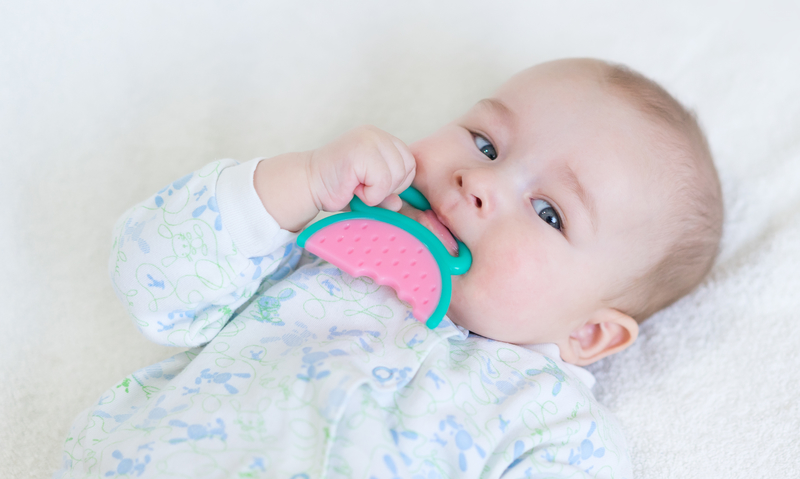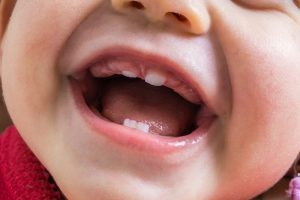Teething and Tooth Eruption: What to Know
Keep Your Teeth Healthy Through the Holidays
December 14, 2018How Braces Can Help You Avoid Dental Problems
December 28, 2018
Almost every single baby is not born with teeth already in their mouth. Getting teeth is a process that can take the entire first 3 years of life for some infants to achieve. It all depends on genetics. Teething happens in generally the same order across the board for infants and it can be a painful process for them. Find out what to expect from teething and how to help your little one get through the process!
Baby Teeth
You will have two sets of teeth during your lifetime: the baby teeth and the permanent adult teeth. If you have a child or remember your own childhood, then you may have some memories of losing the baby teeth. This is something that naturally happens with the body as a child grows and develops. Everything in an infant’s body is small. There is only so much room for teeth in the mouth because of an infant’s size, which is why there are tiny teeth instead of large teeth like an adult has.
However, those tiny teeth simply aren’t able to withstand the kind of pressure and work adult teeth get on a daily basis. This is one reason why the body sheds baby teeth for adult teeth. An infant will only have 20 teeth total in their mouth, and they will have those teeth for about 5-8 years depending on the child. It’s rare that a child is born with teeth already in the mouth. Likely, the tiny baby teeth will start to come into the mouth between 3 and 12 months, and all will be in the mouth by age 3. The teeth may come in all around the same time, but they may come in slowly one-by-one as well.
Studies have found that the baby teeth tend to come into the mouth in the same order. Your child will get the top front two teeth first, followed by the bottom front two teeth. The teeth on either side of the first and second sets will start to come in and that process will continue on until the infant has all the teeth. It’s common for the larger molars to come into the mouth around 18 or 24 months, which is why those molars are referred to as the “two-year” molars. The process of getting teeth is called teething.

Infant Dental Exam
Teething can be hard process for your infant, as the teeth literally must push through the gums, breaking up that tissue to squeeze through. The gum area where new teeth are coming in may crack and bleed, and your infant will likely fuss and cry during the times they are getting new teeth. The molars are much larger, and you may experience even more fussiness from a child. If you ever have any reservations about incoming baby teeth or need help with getting your baby through their teething days, you can always call Dr. Hardy’s office for questions or a consultation.
Helping Your Baby with Teething
In fact, it’s actually recommended that infants come in for a routine dental exam by 18 months of age, when some teeth are coming in and the mouth is preparing for more. The American Academy of Pediatric Dentistry recommends that children be seen for an exam as early as 1 year of age or within 6 months of the eruption of the first baby tooth. This is simply to help with teething and to see how the structure of your baby’s teeth and mouth are. This first visit is free and is one that you can hold your baby during.
If your baby is teething, you can do these things to help them through the process both before and after you come in for your infant’s dental visit:
- Give them teething toys. Chewing can help get the teeth through the gums faster. Teething toys that are gel-like and can be put in the fridge may also provide some cold comfort for hurting gums.
- Baby Tylenol or similar products. These can help soothe pain with teething. However, always check medicine labels to make sure your infant is old enough.
- Baby Orajel. Again, check labels before using these products. Orajel and similar topical gels can help numb hurting gums.
- Wet a washcloth, put it in a baggie and place in the fridge or freezer. They can chew on the washcloth (without the baggie) to ease discomfort and pain .
- Gently rub your baby’s gums with your fingers after washing your hands. This massaging helps some babies.

Transitioning to Adult Teeth One Day
As soon as that first tooth comes into the mouth, make sure you are brushing and cleaning it. This helps prevent decay. Starting cleaning out early will help an infant get used to oral care at an early age. They can fight back against brushing and flossing if you wait until they are older. Teething and tooth eruption is a great time to get to know your baby’s mouth and how to take care of it.
Make sure you are brushing their delicate teeth with specified baby toothpaste. A gentle rubber gum brush will help with delicate baby teeth to prevent irritation with the gums. These are small brushes that fit right over your finger and make brushing more enjoyable for infants. Transition to a baby toothbrush when an infant grows a bit more and become comfortable with using a toothbrush with bristles.
Getting teeth in the mouth is an exciting time for infants, even if it is uncomfortable. Meticulous care must happen so that a child keeps their teeth until 5-8 years old when they start to fall out for the adult teeth to come in. Make that transition happen on time by limiting or avoiding all sugar foods. Never leave a baby with a bottle overnight or for naps, as sugars in the milk can cause decay quickly. For our guidelines for seeing a dentist and orthodontist for regular visits, call Hardy Pediatric Dentistry & Orthodontics today at (720) 887-6003!